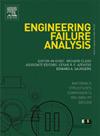Measured dynamic load distribution of high-speed train axlebox bearing with spalling-type faults
IF 5.7
2区 工程技术
Q1 ENGINEERING, MECHANICAL
引用次数: 0
Abstract
Determining the residual safe service life of high-speed train axlebox bearings with spalling faults has become an increasingly critical concern for Chinese railway operators. Crucially, measured dynamic load distributions within bearings exhibiting incipient spalling enable predictive modeling of spall progression and remaining usable life. This study employed a strain-based methodology to quantify internal dynamic load distributions within axlebox bearings with spalling-type faults. By establishing definitive spatiotemporal mappings between strain response characteristics and fault-specific signatures (outer-ring, inner-ring, roller), decoupled identification of all three fault types is achieved. The result of measured dynamic load distribution indicates that outer ring faults induce M-distributed radial loads that amplify adjacent stresses, accelerating spalling propagation. The bearing row with inner ring/roller faults maintain arched distributions but exhibit wider contact load fluctuations than the faultless row, while compound faults manifest hybrid signatures. Besides, compared to the significant impact of bearing misalignment, spalling-type faults exert negligible influence on inter-row load allocation. Position-specific contact load spectra are compiled based on measured roller-raceway contact load histories, providing critical inputs for failure progression models across various bearing fault types.
具有剥落型故障的高速列车轴箱轴承动载荷分布实测
确定高速列车轴箱轴承剥落故障的剩余安全使用寿命已成为中国铁路运营商日益关注的问题。至关重要的是,轴承内测量的动态载荷分布显示早期剥落,可以对剥落进展和剩余使用寿命进行预测建模。本研究采用了一种基于应变的方法来量化具有剥落型故障的轴箱轴承内部动态载荷分布。通过在应变响应特征和故障特定特征(外环、内环、滚子)之间建立明确的时空映射,实现了对所有三种故障类型的解耦识别。实测动载荷分布结果表明,外环故障诱发m分布径向载荷,放大相邻应力,加速剥落传播。有内圈/滚子故障的轴承列保持拱形分布,但比无故障的轴承列表现出更大的接触载荷波动,而复合故障则表现出混合特征。此外,与轴承错位的显著影响相比,剥落型故障对排间载荷分配的影响可以忽略不计。特定位置的接触载荷谱是根据测量的滚子-滚道接触载荷历史编制的,为各种轴承故障类型的故障进展模型提供关键输入。
本文章由计算机程序翻译,如有差异,请以英文原文为准。
求助全文
约1分钟内获得全文
求助全文
来源期刊

Engineering Failure Analysis
工程技术-材料科学:表征与测试
CiteScore
7.70
自引率
20.00%
发文量
956
审稿时长
47 days
期刊介绍:
Engineering Failure Analysis publishes research papers describing the analysis of engineering failures and related studies.
Papers relating to the structure, properties and behaviour of engineering materials are encouraged, particularly those which also involve the detailed application of materials parameters to problems in engineering structures, components and design. In addition to the area of materials engineering, the interacting fields of mechanical, manufacturing, aeronautical, civil, chemical, corrosion and design engineering are considered relevant. Activity should be directed at analysing engineering failures and carrying out research to help reduce the incidences of failures and to extend the operating horizons of engineering materials.
Emphasis is placed on the mechanical properties of materials and their behaviour when influenced by structure, process and environment. Metallic, polymeric, ceramic and natural materials are all included and the application of these materials to real engineering situations should be emphasised. The use of a case-study based approach is also encouraged.
Engineering Failure Analysis provides essential reference material and critical feedback into the design process thereby contributing to the prevention of engineering failures in the future. All submissions will be subject to peer review from leading experts in the field.
 求助内容:
求助内容: 应助结果提醒方式:
应助结果提醒方式:


